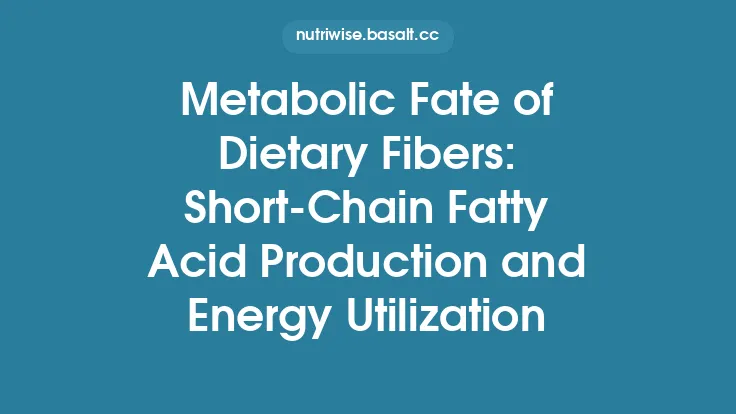The human colon is a bustling ecosystem where trillions of microorganisms break down dietary components that escape digestion in the upper gastrointestinal tract. Among these components, certain dietary fibers serve as the primary substrates for microbial metabolism, leading to the production of short‑chain fatty acids (SCFAs) such as acetate, propionate, and butyrate. These metabolites are not merely waste products; they act as signaling molecules, energy sources, and modulators of host physiology. Understanding how different fiber types are fermented into SCFAs provides insight into the intricate relationship between diet, the gut microbiome, and overall health.
The Biochemical Basis of Fiber Fermentation
1. Enzymatic Machinery of Gut Microbes
Anaerobic bacteria in the colon possess a diverse repertoire of carbohydrate‑active enzymes (CAZymes) that cleave the glycosidic bonds of complex polysaccharides. Glycoside hydrolases, polysaccharide lyases, and carbohydrate esterases work in concert to depolymerize fibers into mono‑ and oligosaccharides, which are then funneled into central metabolic pathways.
2. Primary Fermentation Pathways
Once liberated, sugars enter glycolysis or the phosphoketolase pathway, generating pyruvate. Pyruvate is a pivotal node that can be reduced to lactate, converted to acetyl‑CoA, or decarboxylated to form propionate via the succinate or acrylate routes. Acetyl‑CoA can be further processed to acetate or, through the butyryl‑CoA:acetate CoA‑transferase (or the butyrate kinase) pathway, to butyrate. The relative flux through each route depends on the microbial community composition and the specific fiber substrate.
3. Electron Acceptors and Redox Balance
Fermentation is an anaerobic process that must maintain redox balance. SCFA production serves as a means to regenerate NAD⁺ from NADH, allowing continuous glycolytic flux. For example, the reduction of acetyl‑CoA to butyrate consumes NADH, while acetate formation releases it, influencing the overall SCFA profile.
Fiber Structural Features that Influence Fermentability
| Structural Attribute | Typical Fiber Examples | Fermentation Characteristics |
|---|---|---|
| Degree of Polymerization (DP) | Arabinoxylans (DP 10‑30) | Moderate DP fibers are readily accessed by a broad range of bacteria, yielding a balanced SCFA mix. |
| Branching Pattern | β‑Glucans (mixed β‑1,3/1,4 linkages) | Highly branched fibers slow enzymatic access, leading to prolonged fermentation and sustained SCFA release. |
| Solubility in Water | Pectins (highly soluble) | Soluble fibers dissolve in the colonic lumen, facilitating rapid diffusion to bacterial cells and early SCFA peaks. |
| Presence of Phenolic Substituents | Lignin‑associated hemicelluloses | Phenolic cross‑links hinder enzymatic attack, resulting in low fermentability and minimal SCFA output. |
While solubility is a factor, the article deliberately avoids overlapping with the “soluble vs insoluble” narrative by focusing on how structural nuances—not the binary classification—drive microbial processing.
Microbial Guilds Responsible for SCFA Production
1. Bacteroidetes
Members such as *Bacteroides thetaiotaomicron* excel at degrading complex polysaccharides through extensive CAZyme repertoires. They predominantly generate acetate and propionate, the latter via the succinate pathway.
2. Firmicutes (Clostridia Cluster)
Clostridial species, including *Faecalibacterium prausnitzii and Eubacterium rectale*, are prolific butyrate producers. Their metabolic routes rely heavily on the butyryl‑CoA:acetate CoA‑transferase system, which couples acetate consumption with butyrate synthesis.
3. Actinobacteria
*Bifidobacterium* spp. employ the bifid shunt (phosphoketolase pathway) to convert oligosaccharides into acetate and lactate, indirectly supporting butyrate production through cross‑feeding interactions with butyrate‑producing Firmicutes.
Cross‑Feeding Interactions: A Cooperative Network
Fermentation is rarely a solitary activity. Primary degraders break down fibers into intermediate metabolites (e.g., lactate, acetate) that secondary fermenters then convert into butyrate. This syntrophic relationship enhances overall SCFA yield and stabilizes the colonic environment. For instance, lactate produced by *Bifidobacterium can be utilized by Eubacterium hallii* to generate butyrate, illustrating the interdependence of microbial guilds.
Factors Modulating SCFA Production in the Colon
1. Dietary Fiber Load and Diversity
A diet rich in a variety of fermentable fibers supplies multiple substrates, supporting a diverse microbial community and a broader SCFA spectrum. Monotonous fiber intake can lead to dominance of a few taxa, potentially skewing SCFA ratios.
2. Transit Time
Colonic residence time dictates the extent of fermentation. Faster transit limits substrate exposure, reducing total SCFA output, whereas slower transit allows more complete fermentation but may also increase gas production.
3. pH Gradient
SCFA accumulation lowers luminal pH, which can inhibit certain bacterial groups while favoring acid‑tolerant species. The resulting pH shift influences the balance between acetate, propionate, and butyrate production.
4. Host Genetics and Immune Status
Host factors shape the microbial ecosystem through mucosal secretions, antimicrobial peptides, and immune signaling, indirectly affecting fermentation efficiency.
Physiological Roles of the Major SCFAs
| SCFA | Primary Metabolic Fate | Key Host Effects |
|---|---|---|
| Acetate | Transported via the portal vein to peripheral tissues; used in lipogenesis and cholesterol synthesis. | Modulates appetite regulation via central pathways; serves as a substrate for peripheral tissues; influences gluconeogenesis. |
| Propionate | Primarily taken up by the liver; enters gluconeogenic pathways. | Lowers hepatic cholesterol synthesis; improves insulin sensitivity; acts on G‑protein‑coupled receptors (FFAR2/3) to regulate inflammation. |
| Butyrate | Preferred energy source for colonocytes; oxidized in the mitochondria. | Enhances epithelial barrier integrity; exerts anti‑inflammatory effects through histone deacetylase inhibition; promotes regulatory T‑cell differentiation. |
These actions underscore why the quantity and proportion of SCFAs generated from fiber fermentation are central to gut health and systemic metabolic regulation.
Analytical Approaches to Quantify SCFA Production
1. In‑Vivo Measurements
- Fecal SCFA Profiling: Gas chromatography (GC) or liquid chromatography‑mass spectrometry (LC‑MS) of stool extracts provides a snapshot of net SCFA production and absorption.
- Portal Vein Sampling: In animal models, direct measurement of SCFA concentrations in portal blood offers insight into systemic availability.
2. In‑Vitro Fermentation Systems
- Batch Cultures: Simulated colonic environments (e.g., anaerobic fermenters) allow controlled testing of specific fibers and monitoring of SCFA kinetics.
- Continuous‑Flow Models (e.g., TIM‑2, SHIME): Replicate the dynamic conditions of the colon, including pH control and transit time, yielding more physiologically relevant SCFA data.
3. Metagenomic and Metatranscriptomic Correlates
Sequencing of microbial DNA/RNA can identify CAZyme gene abundance and expression levels, linking microbial functional potential to observed SCFA outputs.
Practical Implications for Dietary Planning
- Incorporate a Spectrum of Fermentable Fibers: Foods such as oats (β‑glucan), legumes (galactomannan), and certain fruits (pectin) provide substrates that collectively promote balanced SCFA production.
- Mind the Fiber Load: Gradual increases in fiber intake allow the microbiota to adapt, minimizing excessive gas while optimizing SCFA yields.
- Consider Individual Variability: Genetic background, existing microbiota composition, and health status can influence how a person’s gut ferments fiber, suggesting a personalized approach may be beneficial.
Future Directions in Research
Emerging studies are exploring engineered prebiotic fibers designed to target specific microbial pathways, thereby steering SCFA profiles toward desired health outcomes. Additionally, integration of multi‑omics data (metabolomics, metaproteomics, metagenomics) promises a more comprehensive understanding of the fiber‑SCFA axis, paving the way for precision nutrition strategies.
By dissecting the structural attributes of dietary fibers, the enzymatic capabilities of colonic microbes, and the metabolic routes that culminate in short‑chain fatty acid production, we gain a holistic view of a process that is central to digestive health and systemic physiology. This knowledge equips both researchers and nutrition professionals to harness the power of fiber fermentation for optimal health outcomes.





